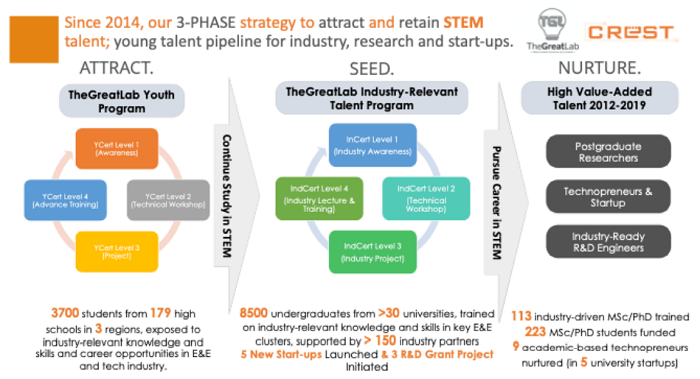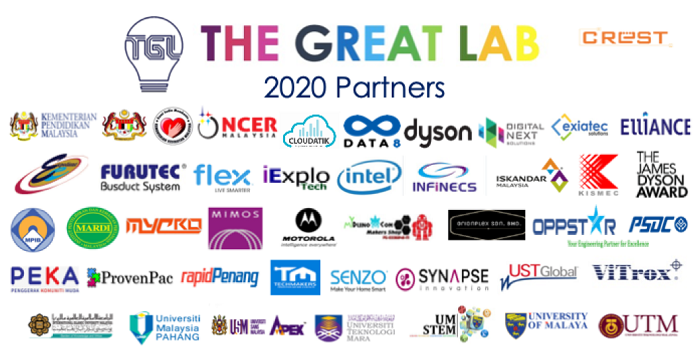CREST creates chemistry for meaningful industry-academia collaboration
By Karamjit Singh December 13, 2021
- Where others talk about industry-academia ties, CREST actually delivers
- Relevance heightened with news of Intel’s new US$7.1bn Penang chip plant

.jpg) Be warned. You better have your morning clear if you are meeting Jaffri Ibrahim (pic, left), the soft spoken, impeccably polite CEO of the Collaborative Research in Science and Technology or CREST, and where your first question is on the impact Crest has had in its nine years of existence.
Be warned. You better have your morning clear if you are meeting Jaffri Ibrahim (pic, left), the soft spoken, impeccably polite CEO of the Collaborative Research in Science and Technology or CREST, and where your first question is on the impact Crest has had in its nine years of existence.
With a total of 165 collaborative R&D projects approved, with participation from 103 companies and 25 universities with 80 projects completed, resulting in a 27% commercialization rate, Jaffri can go on and on about the various programmes Crest has either launched or how it is supporting existent ones.
Based in Penang, due to the state’s strong high tech manufacturing based ecosystem and high demand for skilled technical talent, Crest has been a relatively low profile outfit, that operates in lean mode, not having more than 35 staff at its peak.
But to really get a feel for how Jaffri and Crest have made a difference to the elusive goal of sparking industry-academia collaboration that is meaningful, one needs to talk to academic leaders and industry, which includes the MNCs and homegrown SMEs.
But even without having those conversations, Crest’s relevance to Malaysia’s semiconductor-heavy northern region just went up by a factor of 10 x with news of Intel planning to invest US$7.1 billion (RM30 billion) into a chip facility in Penang.
The academic
There’s Prof Dr Zaidi Mohd Ripin from USM who has seen many government agencies and statements of intent, looking to bring industry and academia together to create win-win situations, but failed. “But Crest has been able to do just that. Maybe they just understand the language of industry and are able to successfully bridge the gap that used to exist,” he says. “The physics may be there but I feel Crest managed to create the chemistry for this long talked about win-win collaboration to happen.”
His own successful collaboration with Motorola Solutions Malaysia Design Centre in Penang in 2012 may not have happened without Crest, Zaidi acknowledges. Brought together by Crest, Zaidi and his USM team solved a wind noise problem for Motorola walkie talkies with the solution patented and Zaidi setting up a consultancy, The Vibration Lab Sdn Bhd which has gone on to serve many global companies.
The SME
Then there’s SME entrepreneur, Goon Koon Yin who credits Crest for catalysing a mindset change in academia, especially at USM, in working with industry. An alumni of USM, he left a career with a Penang based MNC to start TT Vision Technologies in 2001. While he was already working with USM on some collaboration, he says Crest accelerated his collaboration with USM’s E&E school. A key outcome was the development of a machine vision system to detect micro cracks in solar wafers.
The project received a US$30,800 (RM130,000) R&D grant from Crest with a product launched in less than 36-months and which has since generated around RM10 million in sales for TT Vision.
[RM1 = US$0.237]
One key feature of Crest is that its grants are only channelled to the academic partner of any collaboration with industry. “I find the academics value this support which they channel into partial scholarships for students pursuing masters or their PhD,” he says.

The MNCs
Then there are the multinationals which speak highly of Crest and its catalyst role in bringing industry closer in touch with academia. But this is to be expected as Crest, unlike any other public agency, was created specifically to drive close industry-academia collaboration with the end goal of producing relevant engineering talent that Malaysia’s high tech manufacturers, especially our world-leading semiconductor sector needs, while boosting the capabilities of SMEs.
To ensure Crest is industry driven, its entire board is composed of multinationals and Crest’s track record since its launch is testament to what can be achieved when an agency is structured correctly to meet its raison de’ entre.
Eric Chan, vice president of Internet of Things Group, Intel Malaysia points out that Intel, as a founding member of Crest, has had a deep relationship with the agency over the past decade. “Many of Intel’s collaborations with universities have been enabled and supported by Crest,” he says.
Such collaborations happen either with Intel keen to research a particular area and reaching out to Crest to find it a relevant academic partner, or with Crest approaching Intel with an academic partner keen to collaborate.
“I want to highlight that such collaborative research does not always yield a commercial outcome but they key thing is to remember the students and academics that work with us on these projects always walk away enriched by the experience and that those students especially, become highly sought after by industry,” Eric says. Intel does quite a bit of hiring this way as well.
The second key pillar of cooperation is through specific talent development programs and here the latest focus at Crest is on a program called TheGreatLab Challenge, launched in 2014, open to both university and secondary school students. Companies like Intel support this by providing its engineers to act as mentors and even offer real problems they are facing and trying to solve by allowing the students to apply their creativity to the challenges. Intel has even hired students on the spot in this competition. Besides the opportunity to get jobs, Eric says that students also get to establish their first industry contacts through participation in TheGreatLab Challenge. This gives students a window into the culture and job expectations in the MNCs should they decide to apply on graduating.
Eric also highlights the Innovate Malaysia Design project that Crest now lends its support to. A program that has been running for many years, Crest lent its support since 2019. This is an open ended competition in the sense that students will be given a tool kit by Intel, or any other vendor, and then challenged to go look for a pain point they want to solve by using the kit.
[Ed: The writer attended the finals of the 2019 competition in Penang and saw some creative applications built to solve some agriculture issues.]
Jaffri shares that at least 2,400 students have participated in the programs run during
the 2019 – 2020 period. A total of 1319 university students from 23 universities and 686 high school participants from 104 schools took part in 2019.
And despite a pandemic-hit year, 2020 saw 1092 students from 28 education institutions, and 524 participants from 74 high schools benefitting last year.
Having found a winning formula with its industry-driven, project-based blended learning that develops talent to be industry-ready when graduating or going on to their postgraduate studies, Jaffri is not changing for the sake of changing.
“Our approach has been proven to generate these sought after talent by industry and by the number of postgraduate research projects,” he says.
If there is a change, it is in the skills-set that the programs address.
Enter the world of new software technologies such as embedded software, embedded android and cloud engineering. “With software being the new taxonomy in the digital world, we need skilled software engineers who understand these languages,” says Solomon Lorthu, managing director, Motorola Solutions Malaysia.
Working with Crest, Motorola, Intel and other industry players are planning to launch an online platform with USM that marries industry demand for these skills into a curriculum and pilot it at USM. Next year the goal is to open it to all universities in the country to use. It will also be available to unemployed graduates and the employed who want to upskill themselves.”
The quickest way to get this off the ground, the best partner who is in tune with the urgency of rolling out such a platform and with the best relationship with academia was Crest and Jaffri. The small agency has absolutely punched above its weight and Jaffri plans to keep doing so, especially with the talent demands Intel’s new investment will require.
“Over the next few year we are targeting 5,000 new talent at tertiary education level to be trained especially in software engineering related skills through the Engineering Software Talent programme. Alongside this we are looking at 20 new deep tech startups to be seeded from TheGreatLab Challenge and R&D Grant projects with young innovative talent under our proposed Graduate Innovation program,” says Jaffri.
As Crest approaches its 10th year in 2022, Jaffri seems to have another gear to shift up to. Malaysia needs it.


